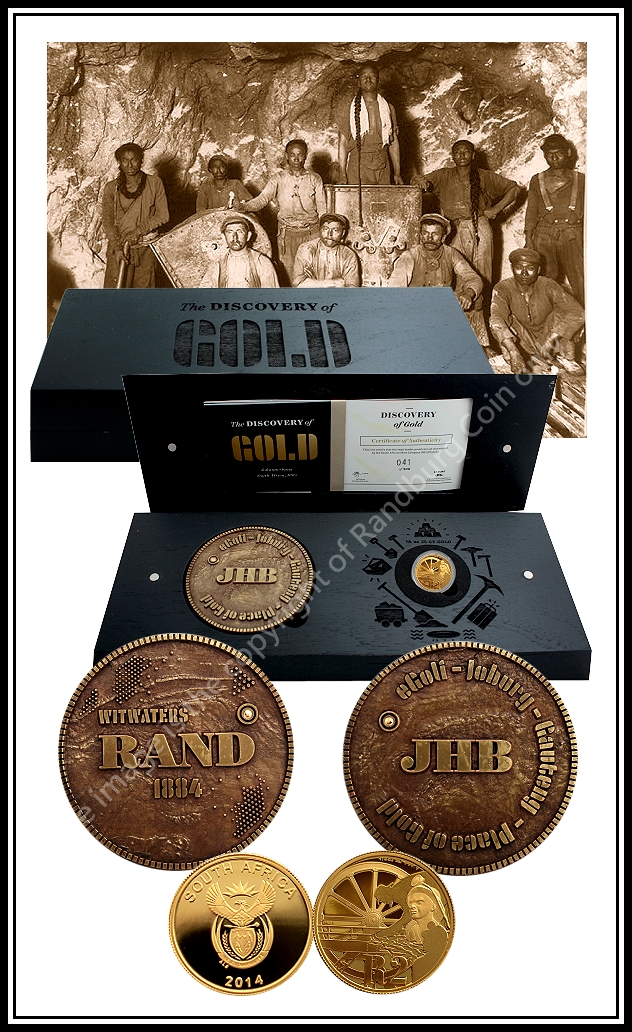|
TAKE ADVANTAGE OF OUR FAIR PRICES
NUMISMATIC COLLECTABLES - HISTORY IN YOUR HANDS
HERITAGE SERIES SETS - GOLD NUMISMATIC LAUNCHES
GOLD AN ASSET CLASS
MAGNIFICENT 24 ct GOLD SET
AT A REDUCED PRICE - A COLLECTORS PRIZE SET
EXTREMELY LOW MINTAGE:
49
LAUNCH SETS ONLY WORLDWIDE
-------------------------------------
2014
DISCOVERY OF GOLD IN SOUTH AFRICA
PROOF R 2 Quarter oz LAUNCH SET
24ct GOLD PROOF COIN - R2 1/4oz
ALLOY MEDALLION - WITH 24ct GOLD INLAY
EXTREMELY LOW MINTAGE LAUNCH SET: 49 WORLDWIDE ONLY
IN A KIAAT WOODEN BOX / CERTIFICATE WITH GOLD MINING TIMELINE
Fanakalo spread to the diamond and gold mines in the South African interior (and subsequently to other African countries) in the late nineteenth century.Fanakalo ‘became the vernacular of black labourers in the mines’: it ‘encompassed instructions and orders’.The mining industry comprises a heterogeneous workforce, employing hundreds of thousands of workers from a multitude of ethnic backgrounds.Workers come from different areas within South Africa, as well as other African countries (for example Mozambique, Zimbabwe and Malawi). One mining operation can include multiple languages such as Xhosa, Sotho, Tswana, Ndebele, Zulu, and languages from Malawi, Swaziland and Mozambique. Therefore, Fanakalo is utilized ‘as a contact language in the mines between people originating from different countries in Southern Africa, and between foremen and workers’ Wessels also mentions Afrikaans and English-speaking Whites, and European (such as Portuguese, Polish and German) immigrants contributing to the requirement of Fanakalo for communication on the mines.
NOW GET NUMISMATIC ITEMS
AT A COMPETITIVE MARKET RATE
AVAILABLE - CALL TO CONFIRM - LIMITED STOCK
 images are generic - images strictly copyright of Randburg Coin images are generic - images strictly copyright of Randburg Coin
FAVOURABLE VALUE
AN EXTRA SPECIAL PRICE
GET YOUR SET NOW FOR ONLY
R 12 500each
WE BELIEVE THESE SELLING PRICES TO BE FAIR
A GREAT PRICE OPPORTUNITY TO OBTAIN THIS SET
SELLING WELL BELOW THE CATALOGUE PRICE
Details:
24ct Gold R2 Weight: 7.77 grams Diameter: 22.0 mm Metal Content: Au 999.9
Alloy Medallion Weight: 150 grams Diameter: 80 mm Metal Content: Alloy Medal with a Gold Inlay: 0.2gram of 24ct AU
EXTREMELY LOW MINTAGE LAUNCH:
49
WORLDWIDE ONLY
Description:
Discovery of Gold in 1884
The first recorded discovery of gold on the Witwatersrand was made by Jan Gerrit Bantjes in June 1884, on the farm Vogelstruisfontein, and was followed soon thereafter, in September, by the Struben brothers who uncovered the Confidence Reef on the farm Wilgespruit, near present-day Roodepoort. However, these were minor reefs, and today it is the general consensus that credit for the discovery of the main gold reef must be attributed to George Harrison, whose findings on the farm Langlaagte were made in July 1886, either through accident or systematic prospecting. Before long open cast workings were being opened up along the full length of the main reef in the present district of Johannesburg.
By August 1886, the mining camp, as yet unnamed, could already boast of some 3000 inhabitants, most of them White, and on 8 September of that year nine farms, located in what is now regarded as the central Rand, were proclaimed public diggings. However Randjeslaagte, the site of present-day central Johannesburg, was not declared until 4 October 1886, and its village was only officially named ‘Johannesburg’ for the first time the previous day, 3 October 1886. The first building plots were subdivided and sold by public auction two months later, on 8 December.
The original miners' camp, under the informal leadership of Col Ignatius Ferreira, had been located in the Fordsburg dip, possibly because water was available there, and because of the site's close proximity to the diggings. Following upon the declaration of Johannesburg, this area was taken over by the Government who had it surveyed and named it Ferreira’s Town.
The sub-division of what became the settlement's central district was a typical product of nineteenth century mining camp planning. In the case of all other gold discoveries made previously in the Transvaal, deposits had invariably proved to have a short working life, so the concentrations of people they stimulated were equally short lived. However, these diggings had also been largely alluvial in nature and, despite the fact that ore deposits on the new reef seemed to be both concentrated and of a long life expectancy, the Government took the view that Johannesburg would be no different from any of the other gold mining villages which had preceded it. As a result, the initial survey and layout of the settlement was made with impermanence in mind. Even after it was realised that the gold reef ran both deep and wide, and the introduction in May 1890 of the MacArthur-Forrest cyanide process made recovery of gold excavated at deep levels economically feasible, the general consensus of the time was that Johannesburg's life span would not exceed 25 years. Thus, initially at any rate, life in the new mining town was one of uncertainty and, for a number of years many of its early buildings retained their prefabricated iron-and-timber character. Source: SA History
|

